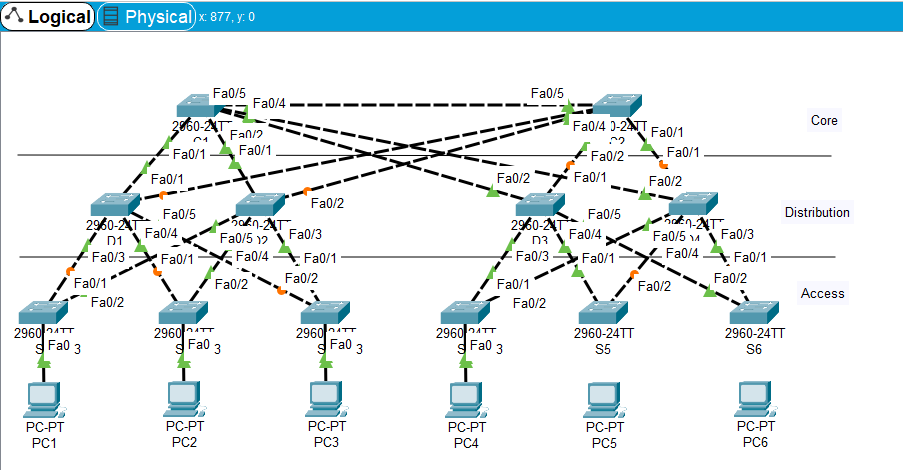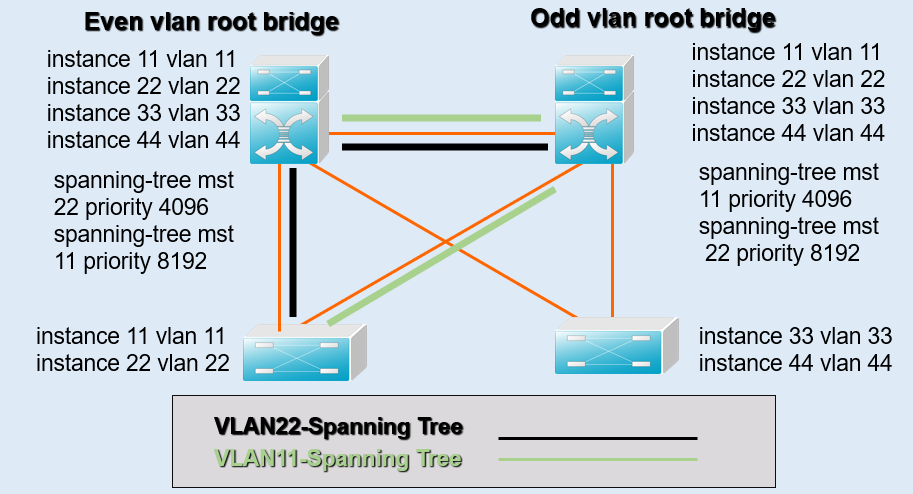标签:range pen real gif muti seve red nali comm
Activity 5.2.5:
Configuring STPNOTE TO USER: Although you can complete this activity without printed instructions, a PDF version is available on the text side of the same page from which you launched this activity.
Learning Objectives
- Examine the STP default state
- Configure the root bridge
- Configure the backup root bridge
- Finalize STP configuration
Introduction
In this activity, the switches are "out of the box" without any configuration. You will manipulate the root bridge election so that the core switches are chosen before the distribution or access layer switches.
Task 1: Examine the STP Default State
Step 1. Examine link lights.
When STP is fully converged, the following conditions exist:
- All PCs have green link lights on the switched ports.
- Access layer switches have one forwarding uplink (green) to a distribution layer switch and a blocking uplink (amber) to a core layer switch.
- Distribution layer switches have one forwarding uplink (green) to a core layer switch and a blocking uplink (amber) to another core layer switch.
Step 2. Switch to Simulation mode.
Step 3. Determine the root bridge.
Click Capture/Forward. Without looking at BPDU detail, MAC addresses, or the show spanning-tree command, can you tell which switch is the root bridge?
Can you think of a reason why this switch is not a good choice as root?
Task 2: Configure the Root Bridge
Step 1. Configure the root bridge.
One of the core switches should be root, and the other should be the backup root. Switch to Realtime mode and configure C1 with a priority of 4096.
Step 2. Switch between Realtime and Simulation modes.
Switch between Realtime mode and Simulation mode several times until all ports on C1 are green.
Step 3. Switch to Simulation mode.
Step 4. Make sure C1 is the root bridge.
Click Capture/Forward several times to watch configuration BPDUs. C1 should be initiating the propagation of BPDUs.
Step 5. Check results.
Your completion percentage should be 17%. If not, click Check Results to see which required components are not yet completed.
Task 3: Configure the Backup Root Bridge
Step 1. Configure the backup root bridge.
The other core switch serves as a backup root bridge. Switch to Realtime mode and configure C2 with a priority of 8192.
Step 2. Switch between Realtime and Simulation modes.
Switch between Realtime mode and Simulation mode several times until all ports on C2 are green.
Step 3. Examine links attached to C2.
What is unique about the C2 links to the distribution layer switches that you do not see with C1 links?
Step 4. Check results.
Your completion percentage should be 33%. If not, click Check Results to see which required components are not yet completed.
Task 4: Finalize STP Configuration
Best practice is to never have an access layer switch become root. You could ensure this by configuring all access layer switches with a priority higher than the default. However, because there are fewer distribution switches, it is more efficient to configure these switches with a slightly higher priority than the backup root switch.
Step 1. Configure distribution switches.
Configure D1, D2, D3, and D4 with a priority of 12288.
Step 2. Check results.
Your completion percentage should be 100%. If not, click Check Results to see which required components are not yet completed.
All contents are Copyright ? 1992?007 Cisco Systems, Inc. All rights reserved. This document is Cisco Public Information.
The topology is shown below:

Specific operation command:

1 C1: 2 Switch>en 3 Switch#conf t 4 Switch(config)#spanning-tree mode pvst 5 Switch(config)#spanning-tree vlan 1 priority 4096 6 C2: 7 Switch>en 8 Switch#conf t 9 Switch(config)#spanning-tree mode pvst 10 Switch(config)#spanning-tree vlan 1 priority 8192 11 D1、D2、D3、D4: 12 Switch>en 13 Switch#conf t 14 Switch(config)#spanning-tree mode pvst 15 Switch(config)#spanning-tree vlan 1 priority 12288
1. Complete the device configuration according to the instructions given above
2. Test the communication of various VLANs by Ping command, including the communication within and between VLANs
3. Observe the forwarding process of ping packet
4. The experiment is completed in PT software, which needs to be realized by PVST+. The example command in the courseware is MSTP configuration command, which is for reference only.
The topology and concrete requirements are shown below:



Specific operation command:

1 =====Switch0:===== 2 Switch>en 3 Switch#conf t 4 5 Switch(config)#vlan 11 6 Switch(config-vlan)#name vlan11 7 Switch(config-vlan)#vlan 22 8 Switch(config-vlan)#name vlan22 9 Switch(config-vlan)#ex 10 11 Switch(config)#int fa0/1 12 Switch(config-if)#swi mode ac 13 Switch(config-if)#swi ac vlan 11 14 Switch(config-if)#no shut 15 Switch(config-if)#ex 16 Switch(config)#int fa0/4 17 Switch(config-if)#swi mode ac 18 Switch(config-if)#swi ac vlan 22 19 Switch(config-if)#no shut 20 Switch(config-if)#ex 21 22 Switch(config)#int range fa0/2, fa0/3 23 Switch(config-if-range)#swi mode trunk 24 Switch(config-if-range)#no shut 25 Switch(config-if-range)#ex 26 27 28 =====Switch1:===== 29 Switch>en 30 Switch#conf t 31 32 Switch(config)#vlan 33 33 Switch(config-vlan)#name vlan33 34 Switch(config-vlan)#vlan 44 35 Switch(config-vlan)#name vlan44 36 Switch(config-vlan)#ex 37 38 Switch(config)#int fa0/1 39 Switch(config-if)#swi mode ac 40 Switch(config-if)#swi ac vlan 33 41 Switch(config-if)#no shut 42 Switch(config-if)#ex 43 Switch(config)#int fa0/4 44 Switch(config-if)#swi mode ac 45 Switch(config-if)#swi ac vlan 44 46 Switch(config-if)#no shut 47 Switch(config-if)#ex 48 49 Switch(config)#int range fa0/2, fa0/3 50 Switch(config-if-range)#swi mode trunk 51 Switch(config-if-range)#no shut 52 Switch(config-if-range)#ex 53 54 55 56 =====Mutilayer Switch0:===== 57 Switch>en 58 Switch#conf t 59 60 Switch(config)#vlan 11 61 Switch(config-vlan)#vlan 22 62 Switch(config-vlan)#vlan 33 63 Switch(config-vlan)#vlan 44 64 Switch(config-vlan)#ex 65 66 Switch(config)#int range fa0/1-3 67 Switch(config-if-range)#swi trunk encapsulation dot1q 68 Switch(config-if-range)#swi mode trunk 69 Switch(config-if-range)#no shut 70 Switch(config-if-range)#ex 71 72 Switch(config)#int vlan 22 73 Switch(config-if)#ip add 192.168.22.1 255.255.255.0 74 Switch(config-if)#no shut 75 Switch(config-if)#ex 76 Switch(config)#int vlan 44 77 Switch(config-if)#ip add 192.168.44.1 255.255.255.0 78 Switch(config-if)#no shut 79 Switch(config-if)#ex 80 Switch(config)#int vlan 11 81 Switch(config-if)#ip add 192.168.11.1 255.255.255.0 82 Switch(config-if)#no shut 83 Switch(config-if)#ex 84 Switch(config)#int vlan 33 85 Switch(config-if)#ip add 192.168.33.1 255.255.255.0 86 Switch(config-if)#no shut 87 Switch(config-if)#ex 88 89 Switch(config)#spanning-tree mode pvst 90 Switch(config)#spanning-tree vlan 22 root primary 91 Switch(config)#spanning-tree vlan 44 root primary 92 Switch(config)#spanning-tree vlan 11 root secondary 93 Switch(config)#spanning-tree vlan 33 root secondary 94 Switch(config)#spanning-tree vlan 22 priority 4096 95 Switch(config)#spanning-tree vlan 11 priority 8192 96 Switch(config)#spanning-tree vlan 33 priority 8192 97 Switch(config)#spanning-tree vlan 44 priority 4096 98 Switch(config)#ex 99 100 Switch(config)#ip routing 101 102 =====Mutilayer Switch1:===== 103 Switch>en 104 Switch#conf t 105 106 Switch(config)#vlan 11 107 Switch(config-vlan)#vlan 22 108 Switch(config-vlan)#vlan 33 109 Switch(config-vlan)#vlan 44 110 Switch(config-vlan)#ex 111 112 Switch(config)#int range fa0/1-3 113 Switch(config-if-range)#swi trunk encapsulation dot1q 114 Switch(config-if-range)#swi mode trunk 115 Switch(config-if-range)#no shut 116 Switch(config-if-range)#ex 117 118 Switch(config)#int vlan 11 119 Switch(config-if)#ip add 192.168.11.1 255.255.255.0 120 Switch(config-if)#no shut 121 Switch(config-if)#ex 122 Switch(config)#int vlan 33 123 Switch(config-if)#ip add 192.168.33.1 255.255.255.0 124 Switch(config-if)#no shut 125 Switch(config-if)#ex 126 Switch(config)#int vlan 22 127 Switch(config-if)#ip add 192.168.22.1 255.255.255.0 128 Switch(config-if)#no shut 129 Switch(config-if)#ex 130 Switch(config)#int vlan 44 131 Switch(config-if)#ip add 192.168.44.1 255.255.255.0 132 Switch(config-if)#no shut 133 Switch(config-if)#ex 134 135 Switch(config)#spanning-tree mode pvst 136 Switch(config)#spanning-tree vlan 11 root primary 137 Switch(config)#spanning-tree vlan 33 root primary 138 Switch(config)#spanning-tree vlan 22 root secondary 139 Switch(config)#spanning-tree vlan 44 root secondary 140 Switch(config)#spanning-tree vlan 22 priority 8192 141 Switch(config)#spanning-tree vlan 11 priority 4096 142 Switch(config)#spanning-tree vlan 33 priority 4096 143 Switch(config)#spanning-tree vlan 44 priority 8192 144 Switch(config)#ex
Test PC configuration instances:

1 PC0: (VLAN 1) 2 IP: 192.168.11.11 subnet mask: 255.255.255.0 default gateway: 192.168.11.1 3 PC1:(VLAN 2) 4 IP: 192.168.22.22 subnet mask: 255.255.255.0 default gateway: 192.168.22.1 5 PC2: (VLAN 3) 6 IP: 192.168.33.33 subnet mask: 255.255.255.0 default gateway: 192.168.33.1 7 PC3:(VLAN 4) 8 IP: 192.168.44.44 subnet mask: 255.255.255.0 default gateway: 192.168.44.1
Cisco Packet Tracer :PVST Self-detection Experiment
标签:range pen real gif muti seve red nali comm
原文地址:https://www.cnblogs.com/elegantcloud/p/14923871.html